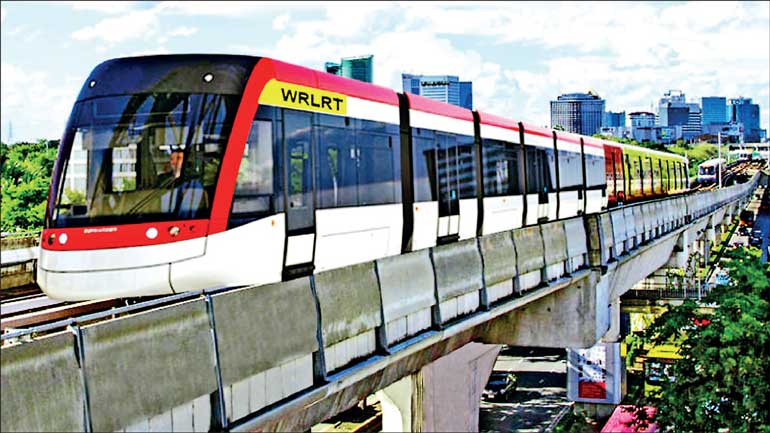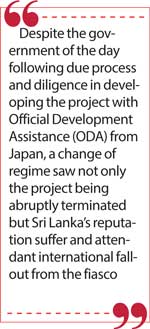Sunday Dec 14, 2025
Sunday Dec 14, 2025
Friday, 27 December 2024 00:28 - - {{hitsCtrl.values.hits}}

GOSL decided to terminate the project with no alternative solution to the traffic congestion issue being proposed
 On 27 December, the railway community in Sri Lanka as well as national-minded islanders commemorate the day on which the inaugural Ceylon Government Railway (CGR) train ran between Colombo Fort and Ambepussa (34 miles on the main line) in 1864.
On 27 December, the railway community in Sri Lanka as well as national-minded islanders commemorate the day on which the inaugural Ceylon Government Railway (CGR) train ran between Colombo Fort and Ambepussa (34 miles on the main line) in 1864.
A day before that, the same demographic remembers with grief and sorrow the cataclysmic effect of the Indian Ocean tsunami which devastated a 1,500 passenger train at Peraliya on 26 December 2004, taking a toll of over 1,000 lives in a disaster that saw an estimated 30,000 deaths.
To the credit of Sri Lanka Railways, the destroyed locomotive – a Class M2a EMD-G12 (‘Manitoba’), imported under the Colombo Plan in 1956 – was fully restored a few years later, and makes its regular run on ‘D-Day’ annually, heading Train No. 8051 (#51).
And in a trifecta of rail happenings, this December’s media has been rife with reports of how the Government of Sri Lanka is in talks with its counterparts in Japan to get back on track the much vaunted Light Rail Transit (LRT) project that was arbitrarily derailed by the Gotabaya Rajapaksa administration in 2021.
Then Sri Lanka’s so-called “LRT fiasco” and the international fallout from a former regime’s ad-hoc policy decision is much in the news these days... for the right reasons, for a change.
So much so that the case study of an arbitrary cancellation of the Japan-funded Light Rail Transit project in the context of international relations in an emerging geopolitical milieu may make interesting reading for all of SLR’s swains and stakeholders in good governance being restored.
Ergo, this two-part piece on Sri Lanka’s ill-fated LRT project, on which fortune and the Government of Japan seem to be smiling again.
Abstract
Vehicular congestion has long been an issue in Colombo, the commercial capital of Sri Lanka, and especially its business boroughs and suburban areas, from which and back to where millions of commuters travel daily.
The railway network, which could have served to alleviate some of this congestion, is derelict and unable to function well as a public transport solution in its own right. Thus the feasibility of a Light Rail Transit (LRT) system to serve the metropolitan periphery for the Colombo Business District (CBD) was hailed and welcomed globally as a viable and efficient solution to a longstanding problem.
However, despite the government of the day following due process and diligence in developing the project with Official Development Assistance (ODA) from Japan, a change of regime saw not only the project being abruptly terminated but Sri Lanka’s reputation suffer and attendant international fallout from the fiasco.
Introduction
The ‘Good Governance’ (Yahapalanaya) administration of President Maithripala Sirisena and Prime Minister Ranil Wickremesinghe declared as being among its aims the transparent and accountable dispatch of governmental and administrative matters. Among the positive outcomes of such an approach was the welcome Foreign Direct Investment (FDI) and international developmental aid that the government of the day attracted.
A key overseas sponsor at the time was Sri Lanka’s longstanding ally and benefactor in a post WWII and post-Cold War milieu, the government and people of Japan, who with their counterparts in Sri Lanka proposed a Light Rail Transit (LRT) project for Colombo and its suburbs, with the intention of serving the business district and peripheral boroughs.
This two-part article will show that in soliciting and securing the LRT project, the Yahapalanaya administration followed the proper governance procedure, with attention being paid to due process and diligence; that a change of regime saw an ad-hoc policy decision that not only abruptly and unilaterally terminated the project, but also brought the Sri Lankan state into disrepute with its international donors; and eventually, resulted in the continued suffering of the island nation’s people; as well as that with a return to a semblance of ‘good governance’, recent efforts by a fresh government have attempted to revive the project in the disastrous aftermath of the fiscal, financial, socioeconomic and reputational losses incurred.
Discussion and analysis
The Light Rail Transit (LRT) project for Colombo was a long-felt need arising from many factors that included a growing population, an outdated and outmoded public transport system, and the increasing number of road and rail passengers entering the city’s metropolitan area on a daily basis for work, schooling and leisure or entertainment activities.
At the time at which the Japanese-funded LRT project was first seriously considered, the status of this influx into the country’s commercial capital saw 10 million daily passenger trips within the Colombo Metropolitan Region (CMR) and 1.9 million passengers entering the CMR on a daily basis (JICA/Ministry of Megapolis and Western Region Development Project, ‘Light Rail Transit Project’).
 Despite the urgency of travelling from points of origin as far south as Galle and Matara; due east as Avissawella; north-east as Kandy and Kurunegala; and north as Negombo, Chilaw and Puttalam; the average travel speed of trains in the CMR was only 17 kilometres per hour (km/h) and 12 km/h in the smaller Colombo Municipal Council (CMC) area due to the slowness of railway services caused by overcrowded trains; weak lines, ties, points, crossings and other railroad infrastructure; ancient locomotives – some in service since the 1950s, when they were imported from Canada to the then Ceylon under the Colombo Plan; and rush-hour congestion compounded by malfunctioning signals, poor track maintenance and derailments.
Despite the urgency of travelling from points of origin as far south as Galle and Matara; due east as Avissawella; north-east as Kandy and Kurunegala; and north as Negombo, Chilaw and Puttalam; the average travel speed of trains in the CMR was only 17 kilometres per hour (km/h) and 12 km/h in the smaller Colombo Municipal Council (CMC) area due to the slowness of railway services caused by overcrowded trains; weak lines, ties, points, crossings and other railroad infrastructure; ancient locomotives – some in service since the 1950s, when they were imported from Canada to the then Ceylon under the Colombo Plan; and rush-hour congestion compounded by malfunctioning signals, poor track maintenance and derailments.
As a feasibility study conducted sometime in the second decade of the 21st century observed, “With population increase, the need for travel is going to increase exponentially” (JICA/MMWRD), and this was equally true of rail as well as road public transport solutions that needed to be developed.
The same study noted: “The Western Region Megapolis Transport Master Plan was developed encompassing all aspects of transportation to provide a framework for urban transport development in the Western Region Megapolis up to 2035 while giving high priority to improving transport in the Western Region.”
Among the major public transport development initiatives identified in this Western Region Megapolis Transport Master Plan was the introduction of an LRT system as a new and innovative mode of public transport in the Colombo Business District (CBD), and comprising a light elevated railway network that would extend from the CBD and radiate into the populous suburbs of the commercial capital.
Also of importance to note as regards the suitability of the proposed LRT were the number of lines, and the tactical way in which each of these would serve a larger strategic purpose of easing vehicular congestion in Colombo, while alleviating the burden of a derelict, dilapidated and deteriorating railway system that was often and in many instances the relict of a bygone colonial era of transportation.
On the fast track
The proposed elevated railway network would comprise the following short, interconnected routes:
LRT Elevated Line 1 – From Colombo Fort through Kollupitiya, Bambalapitiya, Borella and Union Place, to Maradana (15 kilometres)
LRT Elevated Line 2 – From Colombo Fort through Maradana and Mattakkuliya to Peliyagoda (11.5 km)
LRT Elevated Line 3 – From Dematagoda through Borella, Narahenpita, Kirulapone and Havelock City to Bambalapitiya (10 km)
LRT Elevated Line 4 – From Borella through Battaramulla to Malabe (10 km)
LRT Elevated Line 5 – From Malabe to Kottawa (9.6 km)
LRT Elevated Line 6 – From Malabe to Kaduwela (6 km)
LRT Elevated Line 7 – From Peliyagoda to Kadawatha (13 km)
To underline the planned and prepared nature of the LRT project funded by the Japan International Cooperation Agency (JICA), these elevated lines had all their technical specifications pre-approved by both JICA and the Government of Sri Lanka (GOSL) as follows:
Namely, that it would be a fully elevated Light Railway Transit (LRT) system; with an electrified third rail traction type in the standard gauge for LRTs of 1.435m; and the pilot project would have a route length of 21 kilometres, with 21 stations, so that there would be one station every kilometre or so to serve the suburbs’ transportation needs effectively.
In addition, there was a clear road map towards the development and implementation of the first phase of the LRT, as follows:
Stage 1 – define the service levels of the LRT, define the respective routes of the LRT, define the system requirements to meet the needs of the defined routes, define the operational and management body of the LRT, and conduct the necessary environmental impact assessment (EIA) survey and analysis.
Stage 2 – carry out preliminary design and cost estimations, as well as discern Operational and Management (O&M) costs, in addition to Economic Internal Rate of Return (EIRR), Financial Internal Rate of Return (FIRR), Environmental Impact Assessment (EIA), and Resettlement Action Plan (RAP).
Further, from the initial meetings for discussion, deliberation and decisions between GOSL officers and JICA officials, together with other stakeholders of the project, up to the opening of the LRT’s first phase lines 1 and 4, there was a clear road map with clearly notated milestones.
These included deep discussions with the Project Management Unit of the Ministry of Megapolis and Western Development (PMU-MMWD) and decision-making for each of the topic lists (April, 2016); design works and co-adunations (June, 2016); a detailed feasibility report – DFR (December, 2016); an implementation stage with detailed designs; civil, mechanical and electrical engineering inputs for construction; and LRT system training, testing and trial runs.
Block on the line
In addition to all of the above, the issues, constraints and challenges potentially facing the overall project as well as the initial pilot phase were identified as set out below:
Social, land acquisition and resettlement issues – objections of the public demanding higher compensation prior to relocation, losses for entrepreneurs in the business district because of changing of locations, dealing with the traffic congestion created due to LRT construction activity, limited land being available for resettlement of the vulnerable group currently dwelling in the city limits
Legal issues – no acts of parliament or state regulations being available for LRTs, forming a separate entity for operation and maintenance of the elevated LRT system
Environmental issues – the route of the line, which in some areas would trace along ecologically sensitive zones such as the Thalangama Environmentally Protected Area (EPA) and the Sri Jayewardenepura Kotte Bird Sanctuary, in addition to which the LRT’s Malabe Depot was in a low-lying area prone to flooding during heavy rains especially in the South-West Monsoon season period
Technical issues – no experienced hands with the skills being available in the country, especially key professionals with the requisite engineering, IT and construction industry related know-how; a shortage of manpower for construction and related work; poor coordination among key authorities and agencies that would be involved in the overall project; uncertainty as to what the respective contribution of each stakeholder in the project could or should be; utilities diversion because Colombo is an unplanned city, and records of existing utility plans have not been updated in years
Working along the lines of the road map above, and in July 2016, the Government of Sri Lanka decided in principle to seek Official Development Assistance (ODA) funding from the Japan International Cooperation Agency (JICA) for the implementation of LRT Elevated Line 1 and LRT Elevated Line 4.
Further to this, in September of the same year, JICA decided to examine the feasibility of the Malabe-Kollupitiya section comprising LRT Elevated Line 1 and LRT Elevated Line 4 as a candidate for a Japanese ODA loan.
Finally, in December 2016, the GOSL decided to initiate the procurement process to implement these two lines, which were excluded under JICA financing, on a Build Own & Transfer (BOT)/Public-Private Partnership (PPP) basis.
Work in progress – derailed/re-entrained
Work on the project proceeded apace for 2-3 years, and in 2019, the Government of Japan agreed to grant loan assistance to the value of US$ 1,800 million for the Light Rail Transit (LRT) system project as part of its ongoing solution to the traffic congestion in metropolitan Colombo (Zulfick Farzan, ‘Sri Lanka Expecting to Resume Japan-Funded LRT Project’, 4 May 2024, News 1st).
That quantum of funding was allocated to a phase of the LRT system for Colombo that was designed to construct a 17-km long elevated track including 16 stations to cover major and other important intersections from Colombo Fort to Malabe.
When former UDA mandarin and erstwhile Defence Secretary Gotabaya Rajapaksa was elected to unprecedented power as President of Sri Lanka in November 2019, within months he ordered the immediate termination of the Japan-funded LRT project. That project as a whole was suspended by the instrumentality of a letter issued by the Secretary to the President, on 21 September 2020, stating that the project was not the appropriate cost-effective practical transport solution for Sri Lanka. (The project was suspended following a letter issued by the Secretary to the President on 21 September 2020 citing that the project was not the appropriate cost-effective solution transport solution.)
A subsequent special audit report by the Auditor General of Sri Lanka was to reveal later that this arbitrary decision cost Sri Lanka a sum of money equivalent to Rs. 5.978 billion, incurred by the abrupt decision to terminate the project without any proper study being done and leading to an ‘uneconomic expenditure’ of nearly six billion rupees that had already been spent by the GOSL on the project up to date.
In addition, as the media organisation News 1st reported: “The GOSL decided to terminate the project with no alternative solution to the traffic congestion issue being proposed.” The same media outfit also reported: “The Japan International Cooperation Agency had provided the facility of paying the said loan over a period of 40 years including a grace period of 12 years and the annual interest rate thereon was 0.1 per cent.”
Previously, News 1st had also reported: “In April 2023, the Ministry of Urban Development and Housing said that it had called for a report from an expert committee for the reimplementation of the Colombo Light Rail Transit (LRT) project that had been scrapped by the previous administration.” That media channel also reported: “A proposal to reimplement the project was put forward to the Ministry of Finance and Planning, and a report on it has been called for from the National Operation Centre.”
In July 2023, Sri Lanka’s Cabinet of Ministers approved a proposal to finalise a time frame to form a fresh agreement with the Embassy of Japan’s mission to Sri Lanka, to recommend discussions to revive the proposed LRT project, with a view to start work on the key piece of transport infrastructure once again.
At a more recent briefing in Colombo, on 4 May 2024, Sri Lanka’s Foreign Minister told reporters in the Sri Lankan commercial capital that the island nation “welcomes official development assistance extended to Sri Lanka over the past decades through JICA as one of the country’s key development partners”.
The presence at the same briefing of his counterpart, the Japanese Minister of Foreign Affairs, conveying Japan’s intention to further support Sri Lanka in its ongoing development efforts, indicated that reactivating discussions on the LRT could bear fruit in the near future.
The Government’s positive sentiments about revival of the Light Rail Transit project were further underlined by sentiments expressed by the head of state.
As the Colombo Gazette online journal reported: “President [Ranil] Wickremesinghe emphasised his focus on ensuring the swift resumption of the investment projects, including the expansion of the BIA [Bandaranaike International Airport], the LRT [Light Rail Transit] and the Central Expressway.” (Colombo Gazette, ‘Sri Lanka Keen to Resume LRT Project Soon’, 14 February 2024)
That web newspaper also reported the country’s present chief executive, under whose previous premiership the LRT project was first proposed, as being in favour of such a resuscitation of this key piece of infrastructure: “Sri Lanka is keen to resume the Japanese-funded Light Rail Transit (LRT) project soon, President Ranil Wickremesinghe said.”
The presence of the President of the Japan International Cooperation Agency (JICA), in a frame of mind that “expressed gratitude for President Wickremesinghe’s commitment to the economic reform programme” (Colombo Gazette), bodes well for the impending resumption (as of mid 2024) of the once hastily abandoned LRT project.
[To be continued]
| Editor-at-large of LMD | On the fast track again |